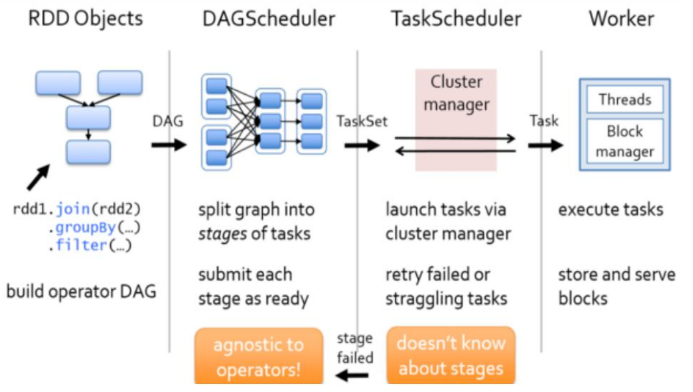
-
Spark 资源调度与任务调度的流程(Standalone):
-
启动集群后, Worker 节点会向 Master 节点汇报资源情况, Master掌握了集群资源状况。
-
当 Spark 提交一个 Application 后, 根据 RDD 之间的依赖关系将 Application 形成一个 DAG 有向无环图。
-
任务提交后, Spark 会在任务端创建两个对象: DAGSchedular 和 TaskScheduler
-
DAGSchedular 是任务调度的高层调度器, 是一个对象
-
DAGScheduler 的主要作用是 将 DAG 根据 RDD 之间的宽窄依赖关系划分为一个个的Stage, 然后将 stage 以 TaskSet 的形式 提交给 TaskScheduler
-
TaskScheduler 是任务调度的底层调度器
-
TaskSet 其实就是一个集合, 里面封装的就是一个个task任务, 也就是stage中的并行度 task 任务
package org.apache.spark.scheduler import java.util.Properties /** * A set of tasks submitted together to the low-level TaskScheduler, * usually representing missing partitions of a particular stage. * 一同被提交到低等级的任务调度器的 一组任务集, 通常代表了一个特定的 stage(阶 * 段) 的 缺失的分区 */ private[spark] class TaskSet( // 任务数组 val tasks: Array[Task[_]], // 阶段Id val stageId: Int, // 尝试的阶段Id(也就是下级Stage?) val stageAttemptId: Int, // 优先级 val priority: Int, // 是个封装过的Hashtable val properties: Properties) { // 拼接 阶段Id 和 尝试的阶段Id val id: String = stageId + "." + stageAttemptId // 重写 toString override def toString: String = "TaskSet " + id } -
TaskScheduler 会遍历 TaskSet 集合, 拿到每个 task 后将 task发送到 Executor 中执行
-
其实就是发送到Executor中的线程池ThreadPool去执行
-
当 task 执行失败时, 则由TaskSchedular负责重试, 将 task重新发送给 Executor 去执行, 默认重试 3 次
//提交task,最后一行 backend.reviveOffers() 调用的是CoarseGrainedSchedulerBackend对象中的方法 override def submitTasks(taskSet: TaskSet) { // 获取任务数组 val tasks = taskSet.tasks logInfo("Adding task set " + taskSet.id + " with " + tasks.length + " tasks") // 加同步锁 this.synchronized { // 创建任务集管理器 参数: 任务集, 最大容忍任务失败次数 val manager = createTaskSetManager(taskSet, maxTaskFailures) // 阶段Id val stage = taskSet.stageId // taskSetsByStageIdAndAttempt 是一个 HashMap[Int, TaskSetManager] /* getOrElseUpdate(key: A, op: => B): B= * 如果 key 已经在这个 map 中, 就返回其对应的value * 否则就根据已知的表达式 'op' 计算其对应的value 并将其存储到 map中, 并返回该 value */ val stageTaskSets = taskSetsByStageIdAndAttempt.getOrElseUpdate(stage, new HashMap[Int, TaskSetManager]) // 将阶段任务集合设置为任务管理器 stageTaskSets(taskSet.stageAttemptId) = manager // 获取冲突的任务集 如果 stageTaskSets 的任务集 不是传入的任务集 并且stageTaskSets的任务集不是僵尸进程 那么它就是冲突的任务集 val conflictingTaskSet = stageTaskSets.exists { case (_, ts) => ts.taskSet != taskSet && !ts.isZombie } // 如果有冲突的任务集 if (conflictingTaskSet) { throw new IllegalStateException(s"more than one active taskSet for stage $stage:" + s" ${stageTaskSets.toSeq.map{_._2.taskSet.id}.mkString(",")}") } // 通过可调度的构造器创建一个任务集管理器 schedulableBuilder.addTaskSetManager(manager, manager.taskSet.properties) // 如故不是本地提交 或者 没有接收到任务 if (!isLocal && !hasReceivedTask) { // 通过饥饿的计时器 来 根据 固定的比例进行调度 // scheduleAtFIxedRate 方法的三个参数: 时间任务, 延迟时间, 周期 如果延迟时间或周期值为父会抛出异常 starvationTimer.scheduleAtFixedRate(new TimerTask() { override def run() { // 如果没有发送任务 if (!hasLaunchedTask) { logWarning("Initial job has not accepted any resources; " + "check your cluster UI to ensure that workers are registered " + "and have sufficient resources") } else { // 如果发送了任务, 就取消 this.cancel() } } // 默认的饥饿超时临界值: 15s }, STARVATION_TIMEOUT_MS, STARVATION_TIMEOUT_MS) } hasReceivedTask = true } // 调用 CoarseGrainedSchedulerBackend对象中的方法 backend.reviveOffers() } -
如果重试 3 次 依然失败, 那么这个 task 所在的 stage 就失败了
-
如果 stage 失败了则由 DAGScheduler 来负责重试, 重新发送 TaskSet 到 TaskScheduler, Stage 默认重试 4 次。
-
如果重试 4 次 以后依然失败, 那么 该 job 就失败了。
-
一个 job 失败了, Application 就失败了。
-
-
TaskScheduler 不仅能重试失败的 task, 还会重试 straggling(直译是挣扎的, 这边可以意译为缓慢的) task(执行速度比其他task慢太多的task)
/** * TaskScheduler 启动 */ override def start() { //StandaloneSchedulerBackend 启动 backend.start() if (!isLocal && conf.getBoolean("spark.speculation", false)) { logInfo("Starting speculative execution thread") // 启动定期执行推测任务线程 speculationScheduler.scheduleWithFixedDelay(new Runnable { override def run(): Unit = Utils.tryOrStopSparkContext(sc) { // 检查所有活跃的jon中是否有可推测的任务 checkSpeculatableTasks() } }, SPECULATION_INTERVAL_MS, SPECULATION_INTERVAL_MS, TimeUnit.MILLISECONDS) } }// Check for speculatable tasks in all our active jobs. // 检查是否有可推测的任务 def checkSpeculatableTasks() { // 是否应该重新激活 var shouldRevive = false // 加同步锁 synchronized { // 检查是否有可推测的任务(传入执行推测所需的最小时间) shouldRevive = rootPool.checkSpeculatableTasks(MIN_TIME_TO_SPECULATION) } // 如果需要重新激活 if (shouldRevive) { // 就尝试运行推测任务 backend.reviveOffers() } } -
Spark 推测执行机制:
-
如果有运行缓慢的 task, 那么 TaskScheduler 会启动一个新的 task 来与该运行缓慢的 task 执行相同的处理逻辑。
-
两个 task 哪个先执行完, 就以哪个 task 的执行结果为准。
-
在 Spark 中推测执行默认是关闭的。
-
推测执行可以通过 spark.speculation 属性来配置
/** * Return a speculative task for a given executor if any are available * 如果有卡壳的进程,就向已知的executor进程返回一个推测任务 * The task should not have an attempt running on this host, in case * the host is slow. * 该任务不应有任何尝试任务在该主机上运行, 以防止该主机是有延迟的 * In addition, the task should meet the given locality constraint. * 此外, 该任务需要满足已知的本地约束 */ // Labeled as protected to allow tests to override providing speculative tasks if necessary // 标注为 protected 以允许测试 来重写 提供的推测任务(如果需要的话) protected def dequeueSpeculativeTask(execId: String, host: String, locality: TaskLocality.Value) : Option[(Int, TaskLocality.Value)] = { // 从推测式执行任务列表中移除已经成功完成的task speculatableTasks.retain(index => !successful(index)) // Remove finished tasks from set // 1.判断 task 是否可以在该executor对应的Host上执行, 判断条件为: // 2.没有taskAttempt在该Host上运行 // 3. 该 executor 没有在 task 的黑名单中(task 在该executor上失败过, 并且仍在‘黑暗’时间中) def canRunOnHost(index: Int): Boolean = { !hasAttemptOnHost(index, host) && !isTaskBlacklistedOnExecOrNode(index, execId, host) } // 判断推测执行任务集合是否为空 if (!speculatableTasks.isEmpty) { // Check for process-local tasks; // 检查 本地进程任务 // note that tasks can be process-local on multiple nodes when we replicate cached blocks, as in Spark Streaming // 需要注意的是: 当我们备份缓存块时, 任务可以以本地进程 或者 多节点的形式运行 (就像spark流那样) for (index <- speculatableTasks if canRunOnHost(index)) { val prefs = tasks(index).preferredLocations val executors = prefs.flatMap(_ match { case e: ExecutorCacheTaskLocation => Some(e.executorId) case _ => None }); // 如果 executor 进程包含该任务Id if (executors.contains(execId)) { // 就不推测该任务 speculatableTasks -= index // 返回某个本地进程 return Some((index, TaskLocality.PROCESS_LOCAL)) } } // Check for node-local tasks 检查本地节点的任务 if (TaskLocality.isAllowed(locality, TaskLocality.NODE_LOCAL)) { for (index <- speculatableTasks if canRunOnHost(index)) { val locations = tasks(index).preferredLocations.map(_.host) if (locations.contains(host)) { speculatableTasks -= index return Some((index, TaskLocality.NODE_LOCAL)) } } } // Check for no-preference tasks 检查非优先级的任务 if (TaskLocality.isAllowed(locality, TaskLocality.NO_PREF)) { // 遍历 speculatableTasks, 如果有任务能够在主机上运行 for (index <- speculatableTasks if canRunOnHost(index)) { // 获取该task的优先级位置 val locations = tasks(index).preferredLocations if (locations.size == 0) { speculatableTasks -= index return Some((index, TaskLocality.PROCESS_LOCAL)) } } } // Check for rack-local tasks 监察本地构建的任务 if (TaskLocality.isAllowed(locality, TaskLocality.RACK_LOCAL)) { for (rack <- sched.getRackForHost(host)) { for (index <- speculatableTasks if canRunOnHost(index)) { val racks = tasks(index).preferredLocations.map(_.host).flatMap(sched.getRackForHost) if (racks.contains(rack)) { speculatableTasks -= index return Some((index, TaskLocality.RACK_LOCAL)) } } } } // Check for non-local tasks 检查非本地性的任务 if (TaskLocality.isAllowed(locality, TaskLocality.ANY)) { for (index <- speculatableTasks if canRunOnHost(index)) { speculatableTasks -= index return Some((index, TaskLocality.ANY)) } } } None }- 需要注意的是:
- 对于 ETL(Extract Transformation Load) 类型的需要导入数据库的业务需要关闭推测执行机制, 否则会有重复的数据导入数据库。
- 如果遇到数据倾斜的情况, 开启推测执行则有可能导致一直会有 task 重新启动处理相同的逻辑, 任务可能一直处于处理不完的状态。
- 需要注意的是:
-
-
-
粗粒度资源申请 和 细粒度资源申请
-
粗粒度资源申请(Spark)
-
在 Application 执行之前, 将所有的资源申请完毕, 当资源申请成功后, 才会进行任务的调度, 当所有的 task 执行完成后才会释放这部分资源
-
优点
- 在 Application 执行之前, 所有的资源都申请完毕, 每一个 task 直接使用资源就可以了, 不需要 task 在执行前自己去申请资源。
- task 执行快了 => stage 执行就快了 => job 执行就快了 => application 执行就快了
-
缺点
- 直到最后一个 task 执行完成才会释放资源, 集群的资源无法充分利用。(俗称: 占着M坑不拉S)
-
-
细粒度资源申请(MR)
-
Application 执行之前不需要先去申请资源, 而是直接执行, 让 job 中的每一个 task 在执行前自己去申请资源, task执行完成就释放资源。
-
优点
- 集群的资源可以充分利用
-
缺点
- task自己去申请资源,task启动变慢,Application的运行就响应的变慢了。
-
-